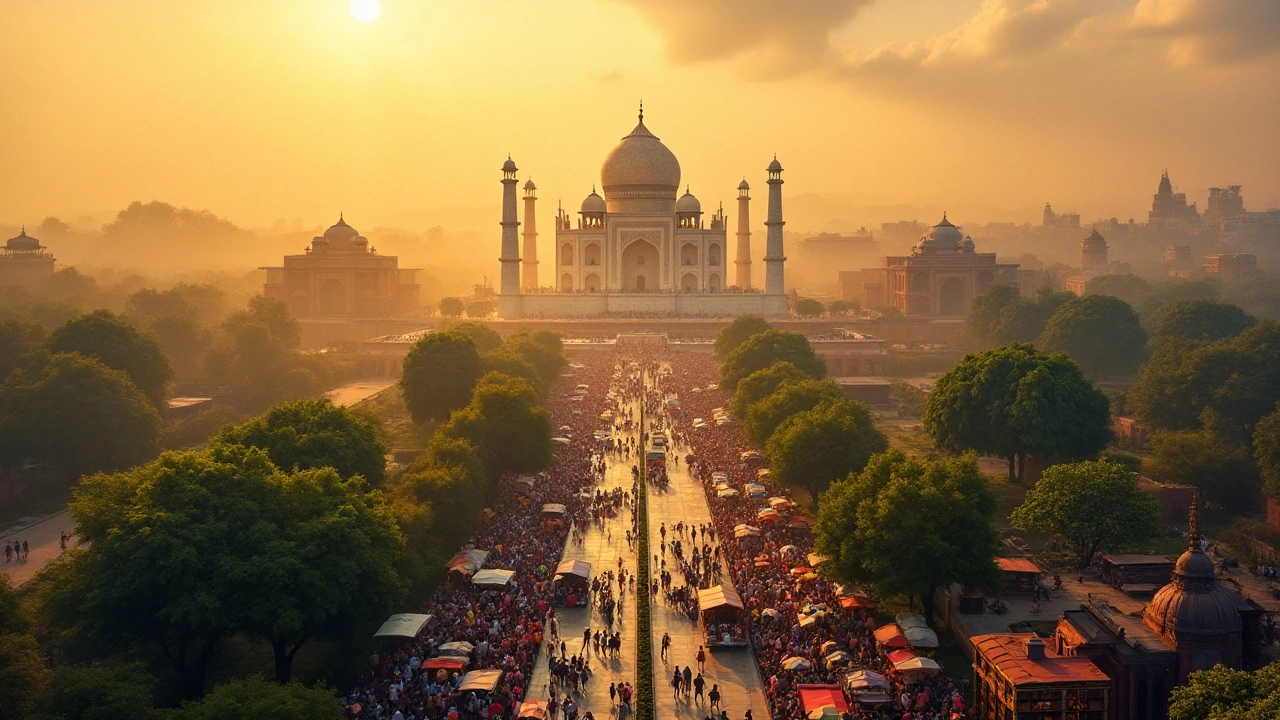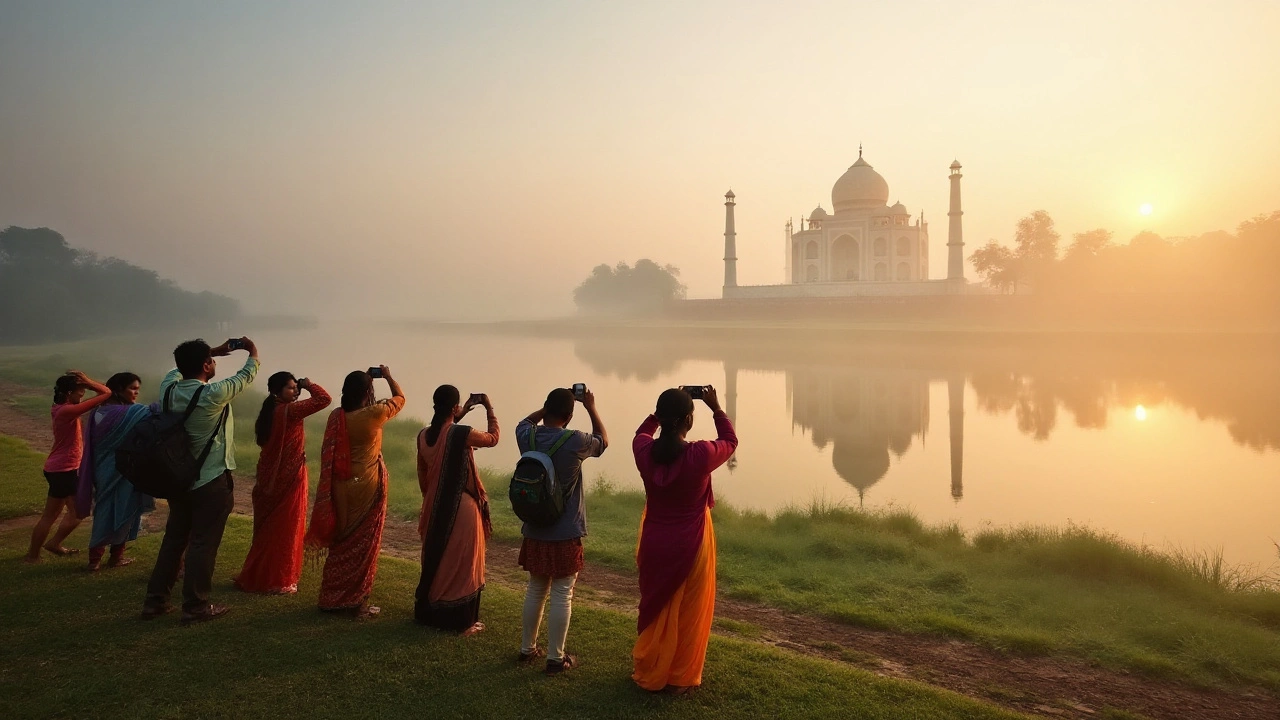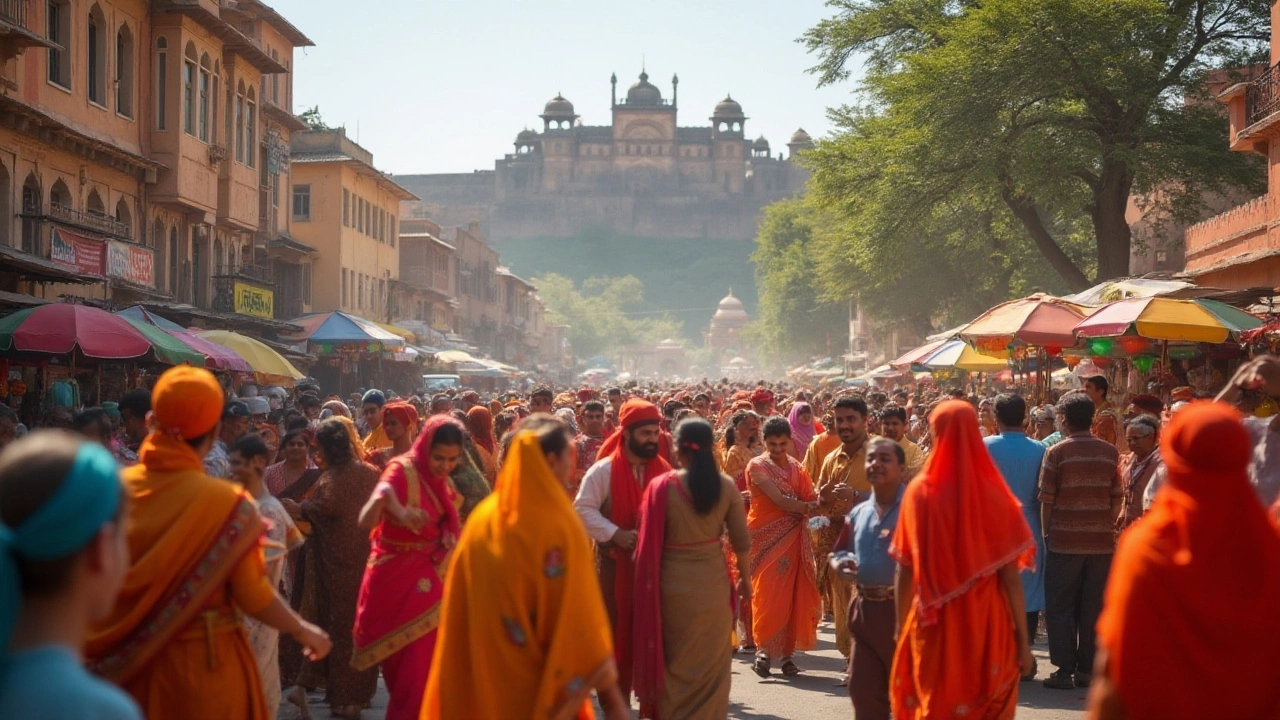Best Time to Explore India's Enchanting Golden Triangle

- Jan, 20 2025
- 0 Comments
- Aaron Blackwood
The Golden Triangle in India, an epic journey through Delhi, Agra, and Jaipur, is nothing short of a kaleidoscope of vibrant history, culture, and awe-inspiring architecture. Travelers from around the world are drawn here, captivated by iconic landmarks and the stories they tell. While you can visit year-round, picking the right time can amplify your experience, making your journey comfortable and unforgettable.
From the majestic Taj Mahal to the bustling bazaars of Jaipur, the Golden Triangle exudes charm and character. Navigating through this incredible route is best done from October through March, when the pleasant weather beckons travelers to explore without the discomfort of the intense summer heat or monsoon rains. These months are particularly favorable as they allow you to enjoy each site leisurely, without being rushed or limited by weather conditions.
- Understanding the Golden Triangle
- Ideal Travel Months: October to March
- Weather Considerations
- Key Attractions to Explore
- Cultural Events and Festivals
- Travel Tips for an Unforgettable Experience
Understanding the Golden Triangle
The Golden Triangle, a famed travel circuit in northern India, forms a literal triangle on the map, connecting three historically rich cities: Delhi, Agra, and Jaipur. Each city, unique in its flavor and charm, offers a myriad of experiences that are sure to leave an indelible mark on any traveler. Delhi, the bustling capital of India, is where most tourists begin their journey. Known for its juxtaposition of the ancient and modern, Delhi's labyrinth of narrow lanes and grand boulevards speak volumes of its rich past and vibrant present. It's home to landmarks like the towering Qutub Minar, the majestic India Gate, and the sprawling Red Fort, each narrating stories of empires gone by.
Moving on to Agra, the city of eternal love, the architecture is an ode to the Mughal era. The crown jewel, undoubtedly, is the iconic Taj Mahal, a white marble mausoleum that draws millions with its poetic beauty and intriguing history. Nearby, the Agra Fort offers insights into the regal past, its red sandstone walls echoing with tales of power and conquest. As the first rays of sun bathe these monuments, they come alive with an almost ethereal glow, making a morning visit a magical experience.
Jaipur, the vibrant capital of Rajasthan, completes the triangle with its colorful palate of palaces and forts. Known as the Pink City due to its distinctly colored buildings, it embodies the royal splendor and dynamic spirit of Rajasthan. Within its boundaries lie architectural marvels like the Hawa Mahal, the majestic Amer Fort, and the City Palace, each offering glimpses into the opulent lives of the erstwhile maharajas and the rich artistry of the craftsmen. The markets of Jaipur, teeming with textiles, jewelry, and crafts, provide a sensory overload that both charms and overwhelms.
Embarking on the journey through the Golden Triangle isn't just a physical traverse; it represents a passage through time, a journey through the pages of history and the heart of India's cultural ethos. Travelers often find themselves enchanted by the kaleidoscope of sights, sounds, and flavors. For those curious about the true essence of India, these three cities provide the perfect window into the country's soul. A visit here is not complete without indulging in the diverse cuisine on offer, from the parathas of Delhi to the spicy curries of Rajasthan. As one traveler aptly put it, 'India’s Golden Triangle is where the past and present coexist in the most beautiful symphony, a place where every corner you turn leaves you breathless.'
‘The soul of India, the pulse that beats in every corner of this majestic land, can be felt in its fullest along the corridors of the Golden Triangle’ – Lonely Planet
Ideal Travel Months: October to March
Visiting India's Golden Triangle during the months from October to March provides travelers with the most gratifying experience due to the welcoming weather conditions. As one embarks on this journey, they find themselves embraced by a period of respite from the extreme summer heat that plagues much of India from April to July. This cooler climate provides a relaxed ambiance, making sightseeing events comfortably accessible. During these months, daytime temperatures typically range from a manageable 15°C to 25°C (59°F to 77°F), offering a pleasant contrast to the sweltering 40°C (104°F) or higher temperatures of summer.
The air quality in these months is also notably improved compared to Delhi's infamous pollution spikes that often occur in the winter. This makes outdoor explorations feel more invigorating and less taxing, allowing each explorer to bask in the splendor of historical monuments and idyllic locations. More visitors find themselves lounging at India Gate or appreciating the grandeur of Humayun's Tomb and the Red Fort under clear blue skies. The capital, during this time, hosts numerous festivals such as Diwali and Dussehra, painting the cityscape with vibrant festivities.
The transition to Jaipur from the bustling streets of Delhi blesses travelers with views of the Amber Fort, standing majestically against the Aravalli hills. This period is also perfect for wandering through the charming lanes of the Pink City, browsing vibrant local markets full of handicrafts, jewelry, and textiles. Whether it’s the Jaipur Literature Festival or colorful Holi celebrations, the cooler months turn an otherwise hot city into a captivating haven. The travel tips Golden Triangle enthusiasts follow during this season emphasize comfortable clothing, breathable fabrics, and sunscreen to make the most of each day.
Arriving in Agra is often the highlight of this tour; witnessing the marbled brilliance of the Taj Mahal at dawn is utterly enchanting. Fog lifts slowly from the Yamuna River, revealing the masterpiece in all its glory. During these months, the number of tourists can be high, so it's advisable to book ahead—this ensures that accommodations and travel plans run smoothly. Many opt to partake in guided tours, which provide in-depth insights and bypass long queues.
According to a survey conducted by renowned travel agency, Lonely Planet, nearly 70% of international travelers favor these months for visiting North India tourism destinations. The cooler temperatures, lack of monsoon rains, and an array of cultural events heighten the appeal of this iconic circuit. Many seasoned travelers believe that the soul of India truly awakens during these months when the blend of culture, climate, and history come together in harmonious symmetry.

Weather Considerations
When planning a journey through the Golden Triangle India, weather considerations are paramount to ensuring a delightful experience. The climate in this region varies significantly across the seasons, influencing everything from sightseeing comfort to photography opportunities. From the blistering heat of the summer months to the refreshing chill of a North Indian winter, each season offers its unique traits. However, one key weather aspect prevails: October through March is widely regarded as the best period for exploration. During these months, the weather remains mild and pleasant, allowing tourists to roam comfortably. Skies are generally clear, providing perfect conditions for marveling at landmarks such as the Taj Mahal bathed in soft morning light or the spellbinding colors of Jaipur’s Hawa Mahal at sunset.
Understanding the specific climatic patterns is essential to making the most of your trip. Come April, the temperatures in the region begin to soar, often reaching above 40 degrees Celsius (104 degrees Fahrenheit). This intensity of heat can be challenging, particularly when wandering among expansive forts or palace complexes under the afternoon sun. Many travelers find themselves retreating to the cool indoors or limiting outdoor activities to early mornings and late evenings, curtailing some of the joys of spontaneous exploration. As the monsoon season sets in by July, sudden downpours, while cooling the air slightly, can also bring with them a deluge that makes certain rural roads difficult to navigate, especially if traveling between the cities by car.
Winter, contrasting sharply with the hot spell, sees temperatures ranging from as low as 5 degrees Celsius (41 degrees Fahrenheit) in the early mornings and evenings to a comfortable 25 degrees Celsius (77 degrees Fahrenheit) during the day. During this season, travelers can indulge in extended outdoor activities, meandering through the historic lanes of Delhi or engaging with the lively markets of Agra, without the worry of overheating or rain-induced discomfort. It's also worth noting that during these months, numerous festivals and cultural events permeate the atmosphere, offering travelers an incredible opportunity to witness traditional celebrations that bring local customs to life.
"The winter months turn the chaos of the Golden Triangle into an enthralling blend of vibrant festivals and perfect weather." – National Geographic Traveller
Noteworthy is the impact of weather on local flora and fauna as well. Visiting during October to March allows visitors to witness gardens and parks, such as the Swaminarayan Akshardham in Delhi, in full bloom, adding another layer of beauty to your trip. For bird enthusiasts, this period also coincides with migratory patterns, making visits to places like Bharatpur Bird Sanctuary a rewarding experience.
To help you plan effectively, here's an overview of the temperatures across different months:
| Month | Temperature (°C) |
|---|---|
| October | 19-34 |
| November | 13-29 |
| December | 8-24 |
| January | 7-22 |
| February | 10-25 |
| March | 15-32 |
With this weather information in hand, travelers can plan excursions, attire, and even the times of day to explore various sites. Aligning your itinerary with the milder season amplifies the positive impact of the trip and ensures every moment spent in the Golden Triangle India is both comfortable and memorable.
Key Attractions to Explore
Embarking on a journey through the Golden Triangle in India promises encounters with some of the country's most cherished sites. Each city, woven into this intriguing circuit, boasts its own unique allure. In Delhi, the bustling capital, you're steeped in an exhilarating blend of old and new. Your exploration must begin with the towering Qutub Minar, a UNESCO World Heritage site, which stands as the tallest brick minaret in the world. Not just a beacon of historical significance, its intricate carvings mesmerize with tales from centuries gone by.
Next on your Delhi itinerary should be the Red Fort, whose robust crimson walls have borne witness to key events in India's past. Designed by the Mughal emperor Shah Jahan, this fort embodies the zenith of Mughal creativity and architectural prowess. Don't miss the Humayun's Tomb, an exquisite prelude to the grandeur of the Taj Mahal. It exemplifies the beginnings of the Mughal architectural style that later flourished throughout the region and beyond.
As you venture to Agra, the undoubted headliner is the Taj Mahal, an everlasting symbol of love. Commissioned by Shah Jahan in memory of his beloved wife Mumtaz Mahal, it spares no corners of opulence with its striking white marble embellishments. If one were to gaze over this 'crown palace' under the moonlight, they'd find enchantment in its ethereal glow. Here, the Agra Fort is often an underrated marvel—its impressive palaces, halls, and gardens encapsulate the might of the Mughal era, making it a must-see en route to the Taj.
In Jaipur, famously referred to as the 'Pink City', vibrant hues reverberate through its streets and architecture. A trip to the Amber Fort, with its stunning hilltop views, is essential. This exquisite fortress entices with tales of Rajput royals and showcases classical architecture with elaborate mirrored palaces. Beyond Amber, the City Palace offers a peek into Jaipur's royal heritage, blending traditional Rajput and Mughal designs. Climbing atop the Hawa Mahal, also known as the Palace of Winds, endows visitors with panoramic glimpses of Jaipur's hive of activity below.
Events and sights around the Golden Triangle aren't only confined to architectural exploits. For example, amidst the Delhi streets, Chandni Chowk unfurls a treasure trove of bustling markets and aromas that promise rich culinary delights. In Agra, the often underexplored Mehtab Bagh provides an alternate vantage point of the Taj Mahal at sunset—a less crowded yet equally stunning experience. Meanwhile, Jaipur's bustling bazaars are replete with handcrafted textiles and gems, a testament to the city's enduring prowess in arts and crafts.
Of course, guiding your journey through these wonders is none other than the locals themselves—people whose stories can turn the complexity of the North India tourism experience into a vivid tableau of enduring warmth. As said by the renowned travel writer Pico Iyer,
"Travel is not really about leaving our homes, but leaving our habits."In the Golden Triangle, indeed, it is about enriching our perspectives through its plethora of sights and stories. When you chart your course across this incredible Indian circuit, each stop becomes a chapter in a richly woven tapestry, unrivaled in its splendor.

Cultural Events and Festivals
Visiting the Golden Triangle India is not just about exploring ancient monuments and architectural marvels; it's also a fantastic opportunity to immerse yourself in the vibrant cultural tapestry of this incredible region. The period from October to March is an ideal time to experience a host of local festivals and events, each offering unique perspectives of the places you visit. These cultural festivities are infused with bright colors, lively music, and traditional dance forms, creating an atmosphere brimming with joy and just pure cultural richness.
In Jaipur, the Pink City comes alive during the Jaipur Literature Festival, usually held in January. This festival is a gathering of the literati from across the globe and provides a platform for discussions, readings, and debates. For an even more exhilarating experience of the Rajasthani culture, plan to visit during the Gangaur Festival, which celebrates spring and harvest. Locals adorn themselves in their best attire, participate in street processions, and relish festive delicacies. It's a colorful spectacle, offering glimpses into the life and traditions of Rajasthan's people. A quote from William Dalrymple, a regular at the festival, states,
"It's an explosion of color, a window into a fascinating world of India's lively traditions."
Delhi, on the other hand, offers the International Trade Fair in November, where the world converges to display a wealth of products and innovations. However, if you wish to explore history in a cultural setting, plan your trip around the Republic Day Parade on January 26th. This event showcases India's military strength and a wide variety of cultural tableaux highlighting the diversity and richness of the country. Agra, famous for the Taj Mahal, hosts the Taj Mahotsav in February. This ten-day event is a celebration of the country's art, dance, and music. Attending these events not only enriches your travel experience but also provides souvenirs in the form of memorable experiences.
A unique feature of attending festivals at the Golden Triangle is the underlying principle of hospitality and warmth extended to outsiders. Whether it's through sharing a meal, engaging in dance, or appreciating local handicrafts and arts, each festival embodies the essence of India's famed hospitality. Participating in these events opens up the chance to make new connections and gain a profound understanding of the region's cultural ethos. Let these festivities become an integral part of your trip, adding layers to your journey, making it more than just sight-seeing by dipping into the life, spirit, and traditions of North India.
Travel Tips for an Unforgettable Experience
Embarking on a journey through India's captivating Golden Triangle is an opportunity to create lifelong memories filled with history, culture, and vibrant local flavors. To make sure you get the most out of this adventure, careful planning and some insider tips can go a long way. First off, consider your mode of transport; while many opt for hiring a private car for its convenience and flexibility, the Indian Railways provide a unique and authentic local experience as well. Booking tickets in advance is highly advisable to secure your spot and enjoy a smooth travel experience between the cities. Don't forget to keep your travel documents and essentials handy as you navigate through bustling railway stations or airports.
As you plan your itinerary, make time for the must-see attractions like the Taj Mahal, Amber Fort, and Jaipur's City Palace, but also leave room for spontaneous exploration of lesser-known gems. Engaging with local tour guides can offer rich insights into the history and significance of these attractions, elevating your visit. Beware of tourist traps and scams; always use official and reputed tour operators. When it comes to cuisine, the food is as diverse as the culture itself. Be adventurous yet cautious with street food; sampling local delicacies like pani puri or chaat is a must-try for food enthusiasts, but make sure you consume them from stalls that locals frequent.
Accommodation varies widely in terms of style and budget, from luxurious hotels to budget-friendly guesthouses. Choosing a centrally-located place to stay can save time and money on transit, allowing you to explore more within the limited time. Cultural etiquette plays a vital role in ensuring a harmonious interaction with local communities. Respecting customs, such as removing shoes before entering a temple and dressing modestly, can enhance your travel experience. As security is a concern in any travel plan, safeguarding your belongings and being vigilant in crowded places prevents unwanted situations.
Timing your visit alongside vibrant cultural festivals offers a peek into the essence of Indian traditions and celebrations. Witnessing events like Diwali, Holi, or the Pushkar Camel Fair adds a unique dimension to your trip, but remember to plan accommodations well in advance as these events draw large crowds. Don’t shy away from learning common Hindi phrases; even a simple "Namaste" can open doors and hearts, enabling deeper connections with locals. As Mark Twain rightly expressed, "Travel is fatal to prejudice, bigotry, and narrow-mindedness." Embrace your Golden Triangle journey with an open mind and an adventurous spirit, ensuring an experience that’s not only informative but also transformative.